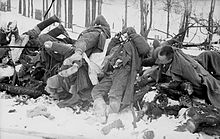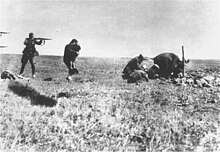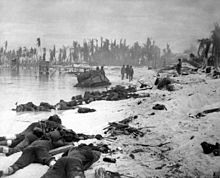Dead of the Second World War
In a narrower sense, people who were killed by acts of war between the beginning of the war in Europe on September 1, 1939 and the surrender of Japan on September 2, 1945, are called deaths , victims or human losses in the Second World War ; in a broader sense, also those who lost their lives as a result of mass crimes in the course of the war and its consequences.
Their total number can only be estimated. Estimates of 60 to 65 million are given for those killed by direct action. Estimates, which include crime and the aftermath of war, range up to 80 million.




Problem
In many of the states involved in and affected by this war, there are few reliable sources and research on the war dead. The methods of the respective estimates are also inconsistent, as are the causes of death, which are viewed as direct or indirect effects of the war.
The exact determination of the number of victims made it more difficult for the Nazi regime, which was mainly responsible for the war, by secrecy, destruction of files and declaring mass murders as consequences of the war. War damage, a lack of demographics and locked archives made research difficult even after the war.
Many of the casualty figures were and are highly controversial, as claims for compensation are based on them. Victims of mass crimes, war crimes and genocide were not always fully recorded and differentiated from other war deaths. Therefore, a wide range of different numbers has been handed down to this day. In many cases, particularly in Eastern Europe, their scientific examination has only begun since 1990.
War deaths by nationality
Figures on the dead in the World War in the individual countries are often methodologically unsecured estimates that are given differently in the literature. The following table is based on data from the tenth volume of the series The German Reich and the Second World War 2008 published by the Military History Research Office . This does not include neutral states and colonies. The estimates given are mostly based on official information from the respective governments. The war dead of the listed states add up to around 65 million people, including more than half civilians.
| country | soldiers | Civilians | total |
|---|---|---|---|
| Australia | 30,000 | 30,000 | |
| Belgium | 10,000 | 50,000 | 60,000 |
| Bulgaria | 32,000 | 32,000 | |
| Republic of China | 3,500,000 | 10,000,000 | 13,500,000 |
| Germany | 5,185,000 | 1,170,000 | 6,355,000 |
| Finland | 89,000 | 2,700 | 91,700 |
| France | 210,000 | 150,000 | 360,000 |
| Greece | 20,000 | 160,000 | 180,000 |
| Great Britain | 270,825 | 62,000 | 332.825 |
| India | 24,338 | 3,000,000 | 3,024,338 |
| Italy | 240,000 | 60,000 | 300,000 |
| Japan | 2,060,000 | 1,700,000 | 3,760,000 |
| Yugoslavia | 740,000 | 950,000 | 1,690,000 |
| Canada | 42,042 | 1,148 | 43,190 |
| New Zealand | 10,000 | 10,000 | |
| Netherlands | 22,000 | 198,000 | 220,000 |
| Norway | 7,500 | 2,500 | 10,000 |
| Austria | 100,000 | 130,000 | 230,000 |
| Philippines | 57,000 | 943,000 | 1,000,000 |
| Poland | 300,000 | 5,700,000 | 6,000,000 |
| Romania | 378,000 | 378,000 | |
| Soviet Union | 13,000,000 | 14,000,000 | 27,000,000 |
| South Africa | 9,000 | 9,000 | |
| Czechoslovakia | 20,000 | 70,000 | 90,000 |
| Hungary | 360,000 | 590,000 | 950,000 |
| United States | 407.316 | 407.316 |
The demographers Marcel Reinhard and André Armengaud quoted the following figures in 1961 (!):
- Total casualties in World War II: approx. 50 million
- Soviet Union: 17–25 million, including 8–9 million soldiers, 9–16 million civilians
- Poland: 5 million, including 3.1 million Polish Jews
- Yugoslavia: 1.5 million, including 1.2 million civilians
- Greece: 500,000
War deaths in relation to the number of inhabitants
| country | Total approx. In% of the country's population | soldiers | Civilians | total | Population in the year (19xx) |
|---|---|---|---|---|---|
| Poland | 17.2% of the population | 300,000 | 5,700,000 | 6,000,000 | 34 849 000 inhabitants (1938) |
| Soviet Union | 14.2% of the population | 13,000,000 | 14,000,000 | 27,000,000 | 190,678,000 inhabitants (1939) |
| Hungary | 10.3% of the population | 360,000 | 590,000 | 950,000 | 9 217 000 inhabitants (1939) |
| Germany | 9.2% of the population | 5,185,000 | 1,170,000 | 6,360,000 | 69 314 000 inhabitants (1939) |
| Netherlands | 2.5% of the population | 22,000 | 198,000 | 220,000 | 8,834,000 inhabitants (1940) |
| Greece | 2.5% of the population | 20,000 | 160,000 | 180,000 | 7 340 000 inhabitants (1940) |
| Romania | 1.9% of the population | 378,000 | 378,000 | 19,934,000 inhabitants (1939) | |
| Finland | 1.2% of the population | 89,000 | 2,700 | 91,700 | 3 698 000 inhabitants (1940) |
| France | 0.9% of the population | 210,000 | 150,000 | 360,000 | 41 510 000 inhabitants (1939) |
| Belgium | 0.8% of the population | 10,000 | 50,000 | 60,000 | estimated approx. 8 million inhabitants (1940) |
| Great Britain | 0.7% of the population | 270,825 | 62,000 | 332.825 | 46,038,000 inhabitants (1931) |
| Italy | 0.7% of the population | 240,000 | 60,000 | 300,000 | 42,943,602 inhabitants (1940) |
| Czechoslovakia | 0.6% of the population | 20,000 | 70,000 | 90,000 | 14,726,158 inhabitants (1930) |
| Bulgaria | 0.5% of the population | 32,000 | 32,000 | 6,341,000 inhabitants (1940) | |
| United States | 0.3% of the population | 407.316 | 407.316 | 132,164,569 inhabitants (1940) |
For comparison: World War I from 1914 to 1918 killed around 3.2% of the French population (1.3 million), around 3% of the German population (2 million) and around 2% of the British population (850,000). The relative number of war deaths in the initially religiously motivated Thirty Years War from 1618 to 1648, in which Catholics initially fought against Protestants in Germany, is estimated to be 20% to 40% of the population.
Victims of German mass crimes in the course of the war
| Victim group | Helmuth Auerbach | Dieter Pohl |
|---|---|---|
| Jews | 6,000,000 | 5,700,000 |
| Soviet prisoners of war | 3,300,000 | 3,000,000 |
| Roma / Sinti | 219,600 | at least 100,000 |
| Euthanasia victim | 250,000 | 270,000 |
| Non-Jewish civilians, concentration camp prisoners, forced laborers, deportees | 3,340,000 | 4,300,000 (with starvation) |
| Total number | 13,109,600 | 13,370,000 |
The numbers of Holocaust victims in particular have been carefully checked several times since 1990 and the previously uncertain number of Soviet and Polish Holocaust victims has been determined more precisely by new sources. The minimum number of 5.7 million and the probable total number of 6.3 million murdered Jews were scientifically proven. The research institute Yad Vashem documented the names of 4 million Holocaust victims by 2010.
Controversial figures
Germany
For Germany, the figures vary between 5.5 (Federal Statistical Office 1991) and 6.9 million war deaths (Population-Ploetz 1965). According to the most detailed study by Rüdiger Overmans (1999), these included 5.3 of 18.2 million German soldiers drafted between 1939 and 1945 (29 percent).
Michel Hubert (1998) attributed the differences in numbers to different underlying territorial boundaries and to whether or not war-related excess mortality , death rates of missing persons, refugees and those who died later in the war were included.
Poland
A government report from 1947 put the number of Polish war dead at 6.028 million; this figure was asserted until 2009 and was considered inviolable. The rapid determination of the number of Polish victims resulted from the necessity of the numbers for the question of reparations.
The Institute for National Remembrance checked this official figure on behalf of the National Ministry of Education and the Polish-German Reconciliation Foundation from June to August 2009. Using a database, it identified 5.62 to 5.82 million Polish war deaths. They include 150,000 Poles who died during the Soviet occupation of eastern Poland from 1939 to 1941. It also includes around three million Polish Jews. The state of research is the number of 5.65 million Polish victims.
Soviet Union
In March 1946, the number of victims has been the Soviet Union of Stalin propaganda purposes with seven million given much too low. From the de-Stalinization to 1985 the official number of 20 million war dead was valid in the Soviet Union. Under Mikhail Gorbachev , some of the Soviet archives have been opened since 1985 and an official total of 27 million Soviet war dead, including 7 million civilians, are given. In 1989, the Russian historian Vladimir I. Kozlov estimated the total number of Soviet war dead at 40 million; In addition to soldiers killed, which he estimated at 15 to 20 million, victims of forced labor, repatriates, Soviet Jews murdered in the Holocaust and those deported to Stalinist camps for war reasons.
A commission set up by Defense Minister Dmitri Timofejewitsch Yasov determined a total of 37 million Soviet war dead between 1987 and 1991, including 8.6 million soldiers and 27 to 28 million civilians. Russian researchers confirm the number of soldiers killed, but some estimate the number of Soviet civilians killed at 17 million.
According to Christian Hartmann, the Soviet Union was affected with around 26.6 million people killed. Including 11.4 million soldiers, of whom 8.4 million died in the fighting and three million in German captivity; however, the largest proportion of the Soviet victims were about 15.2 million civilians who were killed. According to Vladimir Tarasov, the state of research on the Soviet number of victims in 2012 is 26.9 million people.
Czechoslovakia
The exact number of victims of the Nazi regime in Czechoslovakia has not yet been clarified: research estimates between 330,000 and 360,000 victims, including around 270,000 Jews.
Hungary
In Hungary, where the number of victims was a highly politicized question after the Second World War, the human losses add up to 1.2 to 1.4 million according to current calculations.
Neutral states
Switzerland
In Switzerland, a total of 84 people died from British and US bombs between 1939 and 1945 (→ Allied bombings on Switzerland ).
Between 1933 and 1945 around 1,000 Swiss citizens suffered in the Nazi concentration camps, at least 200 of whom died. No violent confrontation has resulted in more Swiss fatalities in the last 200 years. (→ Swiss in Nazi concentration camps )
literature
- Micheal Clodfelter: Warfare and armed conflicts: a statistical reference to casualties and other figures, 1500-2000 , McFarland, Jefferson, NC, 2002 (2nd ed.) ISBN 0-7864-1204-6 .
- Martin K. Sorge: The Other Price of Hitler's War: German Military and Civilian Losses Resulting from World War II. Greenwood Publication Group, 1986, ISBN 0-313-25293-9 .
- New Encyclopedia Britannica: The World Wars , p. 1043.
- Rüdiger Overmans : German military losses in World War II , 3rd edition, Oldenbourg, Munich 2004, ISBN 3-486-56531-1 .
- Rüdiger Overmans: War losses in the context of reparation interests. In: Center for Historical Research (Ed.): History. Yearbook of the Center for Historical Research Berlin of the Polish Academy of Science, Volume 1: War and its consequences. Budrich UniPress, Leverkusen-Opladen 2008, pp. 93-102.
- Rüdiger Overmans: About dealing with the numbers. To evaluate the personnel losses in the Second World War by the Wehrmacht leadership. In: Ernst Otto Bräunche, Hermann Hiery (ed.): History as responsibility. Festschrift for Hans Fenske on his 60th birthday. Heinz Wolf, Karlsruhe 1996, pp. 113-126.
- Rüdiger Overmans: 55 million victims of the Second World War? On the state of research after more than 40 years. In: Military history reports, Volume 48, No. 2/1990, pp. 103–121 ( online ).
- Rüdiger Overmans: The dead of the Second World War in Germany. Balance of research with special consideration of the Wehrmacht and expulsion losses. In: Wolfgang Michalka (Ed.): The Second World War. Analyzes, basic features, research results. Piper, Munich 1989, pp. 858-873.
Web links
- Edina Rauschenberger: Conference report The loneliness of the victims. Methodological, ethical and political aspects of the human casualty count in World War II. 09.12.2011–10.12.2011, Budapest . In: H-Soz-u-Kult , June 8, 2012.
Individual evidence
- ↑ Reinhard Henkys , Jürgen Baumann: The National Socialist Violent Crimes. History and judgment. Kreuz-Verlag, Stuttgart 1964.
- ↑ Rolf-Dieter Müller (Ed.): The German Reich and the Second World War, Volume 10: The collapse of the German Empire in 1945. Half volume 2: The consequences of the Second World War. Deutsche Verlags-Anstalt, Munich 2008, ISBN 978-3-421-04338-2 , The human losses in the Second World War (map with graphic / table), no page number, back cover sheet (= last double page before the back of the book). Sources given there: Der Große Ploetz 2008; Oxford Compendium; Overmans, German Military Losses; Mourik, balance sheet .
- ↑ Thereof more than two million starvation deaths, most of them during the famine in Bengal in 1943 cf. Johannes H. Voigt : India in the Second World War (= studies on contemporary history. Volume 11. Ed. By Institute for Contemporary History ). Deutsche Verlags-Anstalt, Stuttgart 1978, ISBN 3-421-01852-9 , p. 304.
- ^ Marcel Reinhard, André Armengaud: Histoire générale de la population mondiale. Montchrestien, 1961; Received by Michel Hubert: Germany in Transition (quarterly for social and economic history - B). Franz Steiner, 1998, ISBN 3-515-07392-2 , p. 270
- ↑ Hellmuth Auerbach: Victims of the National Socialist tyranny. In: Wolfgang Benz (ed.): Legends, Lies, Prejudices. A dictionary on contemporary history. Dtv, new edition 1992, ISBN 3-423-04666-X , p. 161 f.
- ↑ Dieter Pohl: Persecution and mass murder in the Nazi era 1939–1945. Scientific Book Society, Darmstadt 2003, ISBN 3-534-15158-5 , p. 153.
- ^ Dieter Pohl: Persecution and mass murder in the Nazi era 1933-1945. P. 109.
- ↑ Wolfgang Benz (Ed.): Dimension of the genocide. The number of Jewish victims of National Socialism. Dtv, Munich 1996, ISBN 3-423-04690-2 .
- ^ A b c d e f Edina Rauschenberger: Conference report The loneliness of the victims. Methodological, ethical and political aspects of the human casualty count in World War II. 09.12.2011–2010.12.2011, Budapest . In: H-Soz-u-Kult , June 8, 2012.
- ↑ Wolfgang Köllmann: Population and Space in Newer and Modern Times. (= Space and Population in World History, Population Ploetz, Volume 4). Ploetz-Verlag, Würzburg 1965, p. 189 f.
- ^ Rüdiger Overmans: German military losses in World War II , Oldenbourg, Munich 1999, ISBN 3-486-56332-7 , p. 316.
- ↑ Michel Hubert: Germany in Transition (quarterly for social and economic history - B). 1998, p. 272 and footnotes 3–5
- ^ Knut Krohn (Sächsische Zeitung, June 2, 2009): Poland is counting its war victims for the first time .
- ↑ Agence France Presse, August 26, 2009: Poland corrects the number of its World War II deaths downwards ( Memento of February 19, 2011 in the Internet Archive )
- ↑ Bernd Bonwetsch: The 'Great Patriotic War': From public silence under Stalin to hero cult under Brezhnev. In: Babette Quinkert (ed.): "We are the masters of this country" . Hamburg 2002, p. 173.
- ↑ IW Kurukin: Istorija Rossii IX-XX. Ww. Učebnoje possobije dlja starščeklassnikow i abiturientow. ("History of Russia from the 9th to the 20th Century. Textbook for High School Classes and High School Graduates"), Moscow 2001.
- ↑ Vladimir I. Kozlov: O ljudskich poterjach Sovetskogo Sojuza v Velikoj Otecestvennoj vojne 1941–1945 godov ("On the losses of the Soviet Union to people in the Great Patriotic War 1941–1945"), in: Istorija SSSR 1989/2 , p. 132– 139.
- ↑ Rianovosti, May 7, 2009: The USSR lost around 37 million people in World War II
- ^ Richard Overy : Russian War. 1941-1945. Rowohlt, Reinbek, 2nd edition 2003, ISBN 3-498-05032-X , p. 435 ff.
- ^ Christian Hartmann: Operation Barbarossa. The German War in the East 1941–1945. CH Beck, Munich 2011, p. 115 f.
- ↑ Christiane Brenner : "Between East and West". Czech Political Discourses 1945–1948. Oldenbourg Wissenschaftsverlag, Munich 2009, ISBN 3-486-59149-5 , p. 34.
- ↑ Jörg Krummenacher: Swiss people also died in the Nazi concentration camps - there is no memorial for them yet In: Neue Zürcher Zeitung of August 10, 2018.
- ↑ Peer Teuwsen: Swiss concentration camp victims were forgotten for a long time. Now, for the first time, there is a secure list of victims In: NZZ on Sunday October 26, 2019
- ↑ Nazis killed over 200 Swiss people in concentration camps In: Blick online from October 27, 2019





